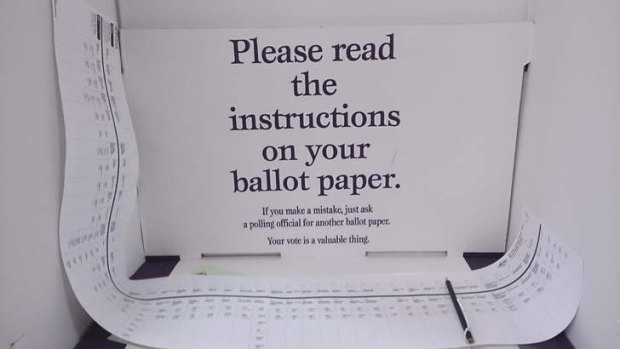This was published 11 years ago
Let's ditch the paper ballots and go electric: Malcolm Turnbull
The man likely to be the new communications minister has suggested Australia should consider a switch to electronic voting at federal elections in order to cut down on informal and fraudulent voting.
Malcolm Turnbull told ABC TV on Tuesday that Australia needed to look at implementing electronic voting, pointing to the large number of informal votes that were cast in the 2013 election.
"I think this is a very, very big issue," he said. "The current system is fraught with errors".
One of the highest ever rates of informal votes was recorded in Saturday's election. According to the Australian Electoral Commission, the informal vote in the lower house has risen from 5.55 per cent in 2010 to 5.91 per cent this year. This is still down on the 6.34 per cent of informal votes cast in the 1984 federal election.

The practice of voting on paper ballots would be replaced by electronic methods if Malcolm Turnbull had his way.
Mr Turnbull said that while some informal votes are protest votes - "there are some people who write 'damn you all, down with politicians"' - the overwhelming majority of them were people making mistakes.
An AEC analysis of informal votes cast at the 2010 federal election found that 28.9 per cent were blank ballots and 16.9 per cent had scribbles, slogans or other protest marks.
The proportion of ballots that only had a '1' was 27.8 per cent, 11.8 per cent had ticks and crosses and 9.2 per cent had non-sequential numbering.
Mr Turnbull, who was easily elected to his Sydney seat of Wentworth on Saturday, said he thought there was also a large number of people who voted fraudulently, "in the sense that they go to the polling place and say they're someone else".
He said he thought many people who did so were voting for a friend or relative who was away or sick - and that this was based on anecdotal evidence he had received since first running for Parliament in 2004.
Impersonating another voter in a polling place is a serious offence and carries a jail term of 6 months.
Mr Turnbull said that electronic voting could be done in a closed network in the polling booth so that it could not be hacked from the internet.
"I think we considerably overestimate the security of the current paper voting system, and we also overestimate the insecurity of electronic voting systems," he said.
He suggested that an electronic system could point out to voters if they were about to cast an informal vote and give them the opportunity to correct it.
Mr Turnbull stressed that his electronic voting suggestion was not Coalition policy, and noted that Australian federal elections are routinely reviewed by a parliamentary committee.
The AEC has been monitoring electronic voting technologies for more than 10 years. The 2007 federal election included electronic voting trials for vision-impaired voters and for ADF and AFP personnel who were overseas and the AEC is expected to soon release a discussion paper on internet voting, to help public debate on the issue.
If electronic voting - either in a localised or remote set up - was to be introduced at the federal level, a change to the Electoral Act would be required.
At the state and territory-level, electronic voting measures have also been trialled since the early 2000s.
For example, the ACT first used electronic voting in the 2001 Assembly election. In the 2011 NSW state election, disabled, remote and interstate voters were able to vote via telephone and the internet.